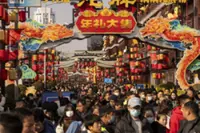Model Marion Caunter learning about Aksara Jawa at Amanjiwo. — T'roka
In Central Java, where life tends to be a little quiet and a lot simpler, learning an ancient script is one way for a visitor to embrace local culture.
Aksara Jawa, in which “aksara” means alphabet, is the ancient script of the Java language used in centuries past. This ancient writing system had a few other names, namely the hanacaraka, carakan and dentawyanjana.





